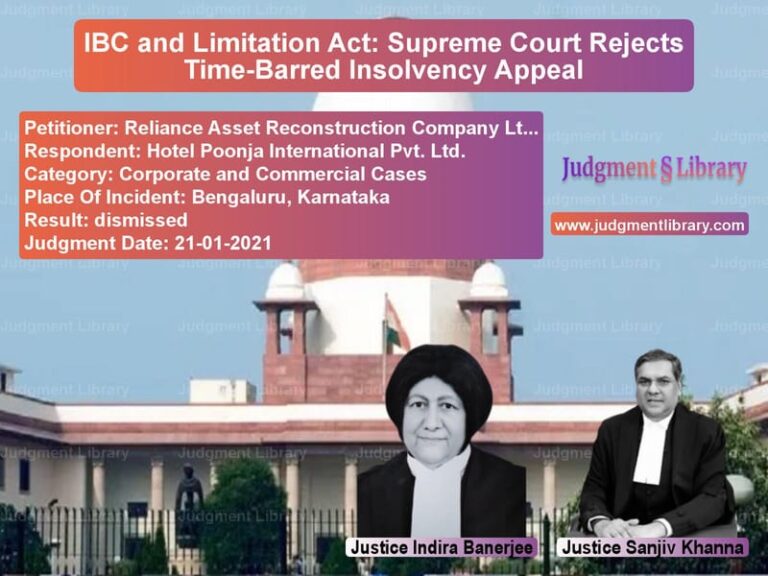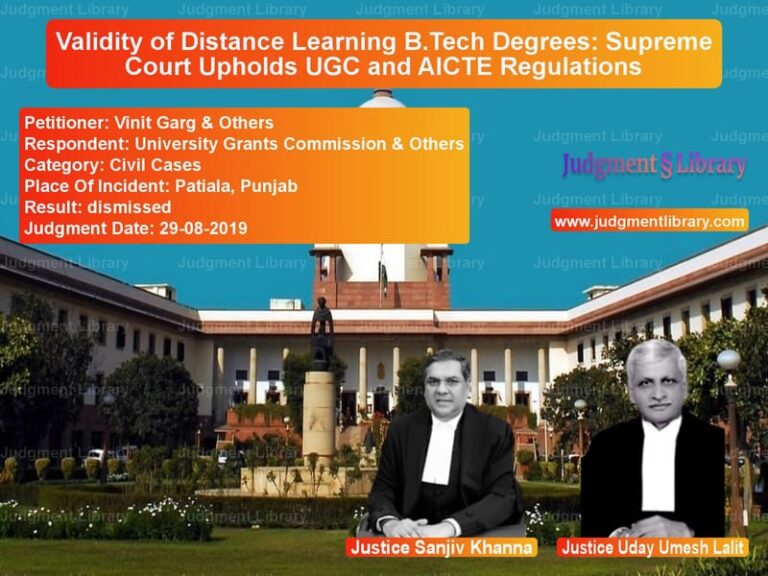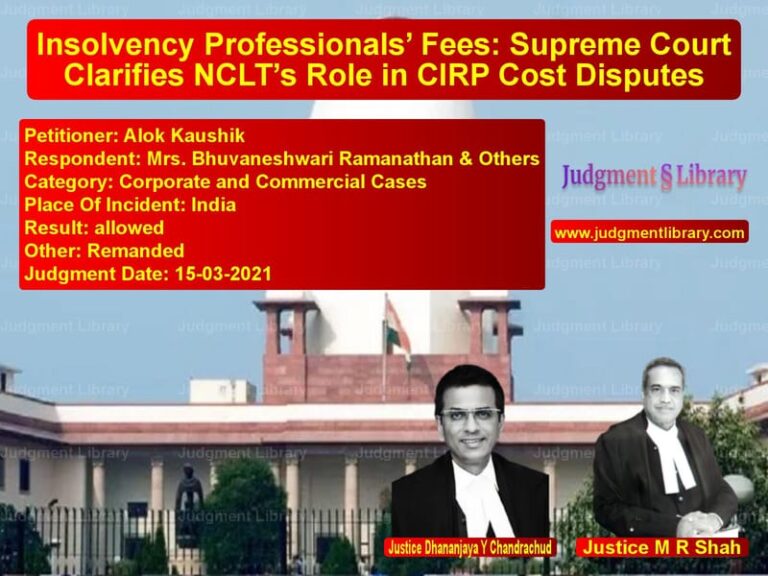Supreme Court Acquits Abhishek Sharma in Murder Case: Dying Declarations Scrutinized
The Supreme Court has overturned the conviction of Abhishek Sharma in the case concerning the murder of Mandeep Kaur. The appellant had been sentenced to life imprisonment under Section 302 of the Indian Penal Code (IPC) by the Delhi High Court, which had upheld the verdict of the Additional Sessions Judge. However, after detailed scrutiny of the multiple dying declarations and other circumstantial evidence, the Supreme Court ruled that the prosecution had failed to prove guilt beyond reasonable doubt, leading to Abhishek Sharma’s acquittal.
Background of the Case
The case revolves around the tragic death of Mandeep Kaur, who succumbed to burn injuries on October 3, 2007. The prosecution alleged that Abhishek Sharma, her colleague at M/s Sai Telecom, was responsible for setting her ablaze due to personal disputes.
According to the prosecution, Mandeep and Abhishek were close friends, but tensions arose when the appellant allegedly developed jealousy over Mandeep’s alleged interest in their employer. The prosecution claimed that on the night of September 20-21, 2007, Abhishek took Mandeep to an isolated spot near Queen Mary School, poured inflammable liquid on her, and set her on fire.
Read also: https://judgmentlibrary.com/supreme-court-slams-forum-shopping-in-criminal-proceedings-imposes-fine/
Arguments by the Petitioner – Abhishek Sharma
The defense presented the following arguments:
- No Direct Evidence: There was no direct eyewitness to the alleged crime, and the conviction was based solely on the dying declarations.
- Unreliable Dying Declarations: The defense pointed out inconsistencies in the four dying declarations made by the deceased.
- Absence of Corroborative Evidence: No forensic or circumstantial evidence, such as proof of Abhishek possessing petrol or a matchbox, was provided.
- Medical Condition of the Deceased: The defense questioned whether Mandeep was in a fit state to give consistent statements, given her severe burn injuries.
- Failure to Follow Legal Procedures: The police did not ensure that the dying declarations were recorded before a magistrate, raising doubts about their authenticity.
Arguments by the Respondent – State (Government of NCT Delhi)
The prosecution defended its case on the following grounds:
- Clear and Consistent Dying Declarations: Mandeep named Abhishek Sharma multiple times as the person responsible for her injuries.
- Opportunity and Motive: The prosecution argued that Abhishek had a motive, given his jealousy over Mandeep’s alleged interest in another person.
- Last Seen Theory: Witnesses confirmed that Abhishek and Mandeep left the office together that night.
- Absconding from the Scene: Abhishek allegedly fled from the crime scene when a PCR van arrived.
- Medical Testimony: The doctors confirmed that Mandeep was conscious and capable of giving statements after the incident.
Key Observations by the Supreme Court
The Supreme Court extensively examined the evidence and made the following crucial observations:
1. Scrutiny of the Four Dying Declarations
The Court noted that Mandeep Kaur made four separate dying declarations, but inconsistencies among them weakened their reliability:
- First Declaration: Given to a police officer in a PCR van, stating that Abhishek Sharma set her on fire.
- Second Declaration: Made to a doctor at the hospital, but the mention of Abhishek’s name appeared to be a later addition.
- Third Declaration: Given to the Investigating Officer, forming the basis for the FIR, but lacked medical certification.
- Fourth Declaration: Allegedly made to Mandeep’s mother, who was an interested witness, making the statement less credible.
The Supreme Court emphasized that for a conviction based solely on a dying declaration, the statement must be free from doubt and manipulation. The presence of contradictions raised concerns about the reliability of these statements.
2. Concerns Over Medical Fitness
The Court questioned whether Mandeep was medically fit to give these statements. It noted that she had suffered 30% burns, and the prosecution failed to produce a medical certificate confirming her mental state at the time of making the declarations.
3. Absence of Corroborative Evidence
The Supreme Court found that:
- No physical evidence, such as a matchbox or petrol container, was linked to Abhishek Sharma.
- The prosecution did not present CCTV footage or mobile location data to establish Abhishek’s presence at the crime scene.
- The police failed to establish how Abhishek allegedly obtained petrol and whether he had prior intent.
4. Police and Judicial Lapses
The Court criticized the investigating authorities for not recording a magistrate-certified dying declaration, which is a standard safeguard to ensure authenticity. The prosecution’s reliance on inconsistent statements weakened the case.
5. Misapplication of the ‘Last Seen’ Theory
The Court ruled that the last seen theory alone is insufficient to convict someone unless there is further evidence proving their involvement. While Abhishek and Mandeep were last seen together, there was no conclusive proof linking him to the crime.
Supreme Court’s Final Ruling
After considering all aspects, the Supreme Court ruled:
- Conviction Overturned: Abhishek Sharma’s conviction under Section 302 IPC was set aside.
- Acquittal Ordered: The Court ordered his immediate release if he was not wanted in any other case.
- Critical Guidelines on Dying Declarations: The judgment reinforced that multiple dying declarations must be consistent and backed by strong medical and corroborative evidence.
Implications of the Judgment
The Supreme Court’s ruling has significant legal implications:
- Strengthening Standards for Dying Declarations: The verdict highlights the need for magistrate-recorded statements to avoid manipulation.
- Reinforcement of ‘Beyond Reasonable Doubt’ Principle: The judgment underscores that courts must thoroughly assess inconsistencies before convicting an accused.
- Critical Examination of Last Seen Theory: The ruling clarifies that mere last seen evidence cannot form the basis of a conviction without corroboration.
- Accountability of Investigative Agencies: The judgment serves as a reminder for law enforcement to follow procedural safeguards in serious cases.
Conclusion
The Supreme Court’s decision in Abhishek Sharma vs. State (Govt. of NCT of Delhi) underscores the importance of procedural fairness in criminal trials. By overturning the conviction due to unreliable dying declarations and lack of corroborative evidence, the ruling reaffirms that justice must be based on clear and unambiguous proof. This case will serve as a benchmark for future trials involving multiple dying declarations and evidentiary inconsistencies.
Petitioner Name: Abhishek Sharma.Respondent Name: State (Govt. of NCT of Delhi).Judgment By: Justice Abhay S. Oka, Justice Sanjay Karol.Place Of Incident: Delhi.Judgment Date: 18-10-2023.
Don’t miss out on the full details! Download the complete judgment in PDF format below and gain valuable insights instantly!
Download Judgment: abhishek-sharma-vs-state-(govt.-of-nct-supreme-court-of-india-judgment-dated-18-10-2023.pdf
Directly Download Judgment: Directly download this Judgment
See all petitions in Murder Cases
See all petitions in Bail and Anticipatory Bail
See all petitions in Judicial Review
See all petitions in Judgment by Abhay S. Oka
See all petitions in Judgment by Sanjay Karol
See all petitions in allowed
See all petitions in Quashed
See all petitions in supreme court of India judgments October 2023
See all petitions in 2023 judgments
See all posts in Criminal Cases Category
See all allowed petitions in Criminal Cases Category
See all Dismissed petitions in Criminal Cases Category
See all partially allowed petitions in Criminal Cases Category







